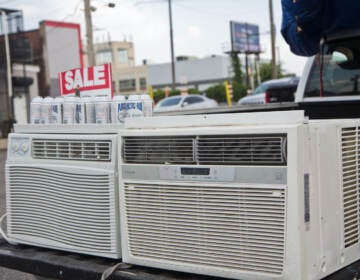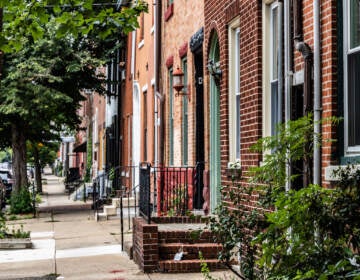As 2017 comes to an end, a look back at Philadelphia’s response to mounting environmental challenges

If everyone keeps their new sustainability resolutions made this year, Philadelphia will be an environmentalist’s dream 15 years from now.
In 2017, the city signed a handful of commitments to dramatically improve energy efficiency by 2030 and reduce landfill waste by 2035.
If city bureaucrats and elected officials keep faith with those pledges, Philadelphia will emit at least 30 percent less carbon into the atmosphere. Municipal buildings will rely solely on clean and renewable electricity, reducing the city’s greenhouse gas emissions by 50 percent, and private buildings will be using half of the energy and water they use today. Many schools, businesses and houses will use rooftop solar or wind generated power, as the city transitions to 100 percent clean and renewable energy. And, as hard to believe as it seems, by 2035 Philadelphia will be waste and litter free.
These local pledges were made in a year marked by rolled back environmental protections at the federal level.
“The best thing [that happened this year] has been this collective action,” said Philadelphia Office of Sustainability Director Christine Knapp. “I just rattled off five or six different commitments, charters and pledges that we sign on to [this year] — and you get a little burnt out by how many of them they are. But on the other side, it’s great to see that there’s so much collective desire to take action and to work together.”
Even if they’re long-term promises, Knapp said many of the prerequisite actions to accomplish those goals are already in place. And all of this was possible, Knapp said, because cities, states, and the private sector felt more urgency and motivation to take action and collaborate in response to reduce environmental protections at the national level.
“The federal government withdrawing from Paris Climate Agreement is the biggest issue of the year,” Knapp said. “For Philadelphia, but for all the U.S. cities that are trying to move our climate work ahead, that was a real blow.”
President Donald Trump’s environmental policies also motivated residents to take action this year. In March local environmental groups urged City Council to give priority to initiatives that would help Philadelphia mitigate and adapt from climate change. And during the year environmentalist rallied to protect the Obama administration’s Clean Power Plan and the Clean Water rule, and to protest against cuts to the Environmental Protection Agency.
FILTHADELPHIA NO MORE
In August, the city made a big commitment when the Zero Waste and Litter Cabinet — an interdepartmental group created by Mayor Kenney in 2016 — presented a roadmap to both reduce and recycle 1.5 million tons of waste Philadelphia disposes every year by 90 percent by 2035. This will save the city $41.5 million dollars annually, according to city officials.
Nic Esposito, the cabinet’s director, said so far 30 percent of the 31 recommendations have been completed, and another 19 percent are in progress. On October, Mayor Kenney signed two bills regarding illegal dumping, the cabinet’s first priority and a huge problem in Philadelphia, to increase penalty fees on short dumping and to expand rewards to individuals who provide information that leads to investigations.
To make sure 519 municipal buildings comply with existing recycling and waste management regulations, the cabinet started a waste audit. And to bring more community engagement through rewarding contributing residents, the city created Philacycle, a new program that brings together Philadelphia Recycling Rewards, the Recyclebank and the Waste Watchers program. Esposito added that the data arm of the plant, the Litter Index, is almost finished and will be launched by the end of January.
“People are very impressed by the professionalism of the plan, and by the action side of it,” Esposito said. “They look at the list of recommendations and say ‘Yes, this is it’.”
Still, Esposito said there is demand for more action. In particular, to speed up a street sweeping program that Mayor Kenney promised in his campaign. The recommendation is listed in the plan, but not as a priority. Esposito said residents will need to “trust the process.”
OUR OWN PARIS CLIMATE AGREEMENT
One of the most important sustainability goals presented this year are the ones set by the municipal energy master plan presented by the Office of Sustainability last October to reduce carbon emissions and mitigate climate change.
The plan creates strategies to reduce the city’s greenhouse gas emissions by half, to lower the energy usage of city buildings — starting with the Philadelphia Museum of Art, the city’s single most energy-hungry infrastructure — and streetlights 20 percent, and to switch to 100 percent renewable electricity by 2030.
“It’s not citywide and it’s not 100 percent,” said Meenal Raval, a member of 350 Philadelphia and Northwest Philly Solar Co-op, after the city presented the plan. But local environmentalist took it as good first step and applauded the city’s renewable energy power purchasing agreement which will allow the city to buy clean and renewable energy at lower prices.
The energy master plan will help the city advance in Mayor Jim Kenney’s pledge to reduce city-wide greenhouse gas emissions by 80 percent by 2050, but also to move forward in two other important promises made by the city this year.
In June, after the Trump administration’s decision to withdraw the United States from the Paris Climate Agreement, Kenney announced Philadelphia will continue to commit to the agreement’s targets of reducing carbon emissions between 26 and 28 percent by 2025. Later that month, he signed into the Sierra Club’s Ready for 100 campaign, an initiative that pushes for a city-wide transition to 100 percent clean and renewable energy. Although he didn’t set a deadline, environmentalist are pushing for 2050.
But for the whole city to reduce carbon emissions and transition to clean energy, Philadelphia needs businesses, residents, and institutions to chip in. For that the city published a draft of it’s vision for a clean energy future in November identifying the sources of carbon emissions and establishing they could be cut or replaced by having a clean electricity supply, citywide solar, energy efficiency homes and businesses, low-carbon thermal energy and a low-carbon economy. The document is open for comment until January 31st.
So far, 16 million square feet of the city’s private building sector are commiting to do it. Last October, Philadelphia — led by Delaware Valley Green Building Council — joined other 20 cities in 2030 District, a project whose goal is to mitigate climate change effects. The goal is to reduce building’s energy and water consumption, and transportation-related emissions, 50 percent by the year 2030.
Residents are also contributing by installing rooftop solar in their homes. This year the Philadelphia Energy Authority launched its Solarize Philly campaign to bring solar installation prices down. From April to October, 186 homeowners signed a contract — including the LoCiceros, a South Philadelphia family who was on the fence of signing in last September — exceeding PEA’s first year goal of 100 contracts. The energy authority announced a second round starting in January next year, this time subsidizing financing for 45 low-and moderate-income households, and to continue to train high school students.
In December, Mayor Kenney joined mayors of other 69 cities pushing for solar energy and promising to continue to make it easier and cheaper for everyone to get.
If the city works to keep this promises, Philadelphia will not only be cleaner and less polluted, but also more prepared for stronger storms, wetter winters, and hotter summers. Neighborhoods like Eastwick, in Southwest Philadelphia, are already impacted by rising sea levels and stronger storm surges. This year, Eastwick has been going through a planning process that may protect them from more flooding but, in the absence of federal regulations, the neighborhood needs local and state policies to neutralize climate change projections.
This year, the city felt the effects of extreme weather, the uptick of which scientists attribute to climate change, that befell parts of the country far from the Delaware Valley. After Hurricane Maria hit Puerto Rico in September, hundreds of displaced people came to Philadelphia. Philadelphia Office of Emergency Management director Dan Bradley said this is the first time the city was forced to respond to a disaster that did not happen here, without the typical disaster tools granted by the federal government. Security experts and urban planners said cities will have to spend more time preparing for influxes of displaced populations pushed by extreme climate events, like hurricanes and droughts.
Overall, Philadelphia’s sustainability chief Christine Knapp said the year has been “challenging but hopeful.”
“There’s great actions happening at the city and state levels,” Knapp said. “I’m trying to keep hope alive.”
Dear reader, we will get straight to the point: Today we ask you to protect PlanPhilly’s independent, unbiased watchdog coverage. We depend on you to bring the news that you value and spread voices across the city. This holiday season, please give the gift of public and accessible media for all by making a tax-deductible donation during our once-a-year membership drive. Thank you for making us your go-to source for news on the built environment eleven years and counting.
WHYY is your source for fact-based, in-depth journalism and information. As a nonprofit organization, we rely on financial support from readers like you. Please give today.







